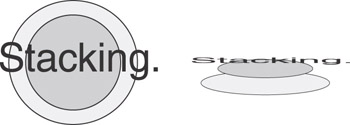Stacking Illustrator Artwork
Stacking Illustrator Artwork
Illustrator automatically accomplishes front-to-back positioning for you in a straightforward, logical way. Each new object that you draw, place, or paste is positioned in front of the last object that you drew, placed, or pasted, resulting in a stack of artwork.
Unless you apply transparency (as I detail in Chapter 10), objects positioned in front of other objects tend to knock out the portions of the objects that they overlap. Figure 13-1 shows Illustrator objects stacked in three different arrangements. The objects are in the same locations, but their stacking order is different. The result is completely different artwork in each example.

Figure 13-1: These arrangements of artwork are a result of changing the stacking order of the objects.
Stacking order
Illustrator treats on-screen objects as if they were playing cards stacked neatly on a table. (Think of yourself as standing next to the table and looking straight down on them. All the individual cards cannot be seen. You only see the topmost card.) Stacking order is the order of objects in the stack. The order of the objects in the stack is typically determined by when they’re created or placed in the document, although you can change this order by using an Object→Arrange command. Read more on the Arrange commands in the upcoming section, “Moving art up (front) or back (down) in the stacking order.” The first object created sits at the bottom of the stack. In Illustrator, this is referred to as the Back. The next object created is in front of that object, and the most recent object created sits on top of all the others. The topmost position is considered to be the Front.
Figure 13-2 shows a basic illustration and an imaginary side-edge view of that artwork as it would appear from the side.

Figure 13-2: The illustration (left), shown from a sideways view (right).
Even when two objects appear visually side by side and do not overlap in any way, Illustrator still considers one object to be in front of the other — as if each object that you create in Illustrator were painted on a separate piece of transparent plastic. Often, the only time you can know the stacking order is when you move one object in front of another. That’s the only time you need to know the stacking order because stacking order makes a difference only when objects overlap. When objects overlap improperly (like if a big yellow triangle hides the word YIELD that you really want in front of the triangle), you can use the Arrange commands to change stacking order.
Moving art up (front) or back (down) in the stacking order
Illustrator offers the following five commands to move objects up and down through the stacking order:
-
Object→Arrange→Bring to Front: This command brings selected artwork to the top of the layer you’re working on (more about layers in the next section) by putting that artwork in front of the other objects.
-
Object→Arrange→Send to Back: This command moves selected artwork to the bottom of the layer you’re working on by putting that artwork behind the other objects.
-
Object→Arrange→Bring Forward: This command brings selected artwork forward (that is, upward in the stack) one step at a time.
-
Object→Arrange→Send Backward: This command puts the selected artwork farther back (that is, downward in the stack) one step at a time.
-
Object→Arrange→Send to Current Layer: This command moves the selected artwork from the layer it resides on to the layer selected in the Layers palette. For more on layers, see the section, “Using the Layers palette,” coming up in this chapter.
Illustrator uses stacking order to keep track of all the objects on-screen, even when they don’t overlap. The Bring Forward and Send Backward commands affect the stacking order, regardless. Whether you send an object backward or bring it forward, you may not see any difference if nothing’s overlapping. Don’t panic! The object really did move in the pecking order.








